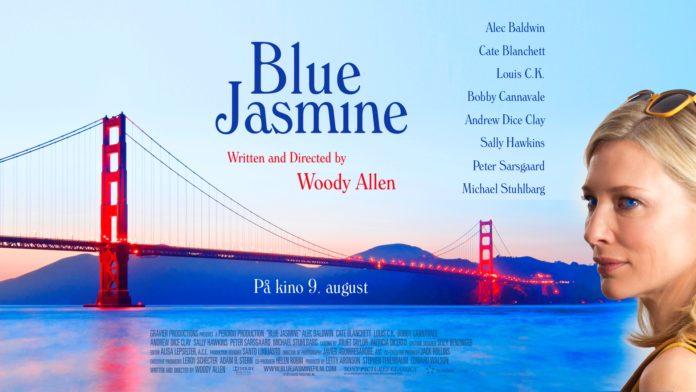In Blue Jasmine, Cate Blanchett delivers what may be her strongest performance yet. Her frenetic, scheming, recast Blanche Dubois tops even her jaw-dropping performance in I’m Not There — the 2007 movie where she plays a highly plausible Bob Dylan.
Jasmine is married to Hal (Alec Baldwin), a sleaze-ball Wall Streeter who delivers the requisite mansion, Hampton home, and yacht. When Hal is exposed as a Bernie Madoff style crook, he goes to prison and Jasmine goes to live with her working class sister in San Francisco. In a clear homage to Tennessee William’s Street Car Named Desire, nothing goes especially well after that.
The movie is in most respects brilliant. Allen is an active director, his camera everywhere, his cuts clean and well-considered. It is hard to argue with the verdict of The New Yorker’s David Denby, who pronounced Blue Jasmine “the strongest, most resonant movie Woody Allen has made in years.” Sally Hawkins and Andrew Dice-Clay deliver solid performances as Jasmine’s adopted sister and her husband who never forgives Hal for costing them the only money they ever had.
 At one level, Blue Jasmine is another in the latest of Allen’s attempts to get out of Manhattan that started with Midnight in Paris and continued with To Rome, With Love. I hope that Parisians and Romans did not cringe at the complete mess Allen made of their city, the way most Bay Area residents will at Blue Jasmine. Woody Allen appears to have not progressed in his view of California since Annie Hall in 1977 where is he famously puts down Los Angeles by declaring to his best friend Marty that “I don’t want to move to a city where the only cultural advantage is being able to make a right turn on a red light.”
At one level, Blue Jasmine is another in the latest of Allen’s attempts to get out of Manhattan that started with Midnight in Paris and continued with To Rome, With Love. I hope that Parisians and Romans did not cringe at the complete mess Allen made of their city, the way most Bay Area residents will at Blue Jasmine. Woody Allen appears to have not progressed in his view of California since Annie Hall in 1977 where is he famously puts down Los Angeles by declaring to his best friend Marty that “I don’t want to move to a city where the only cultural advantage is being able to make a right turn on a red light.”
The working class heros of Blue Jasmine are not San Franciscans — they are from Jersey. In the Bay Area, car mechanics have foreign accents (My mechanic is Yemeni, but you can just about pick your country). Nobody here debates where the best clams are — that happens in New York and Boston. Even in New York, State Department officials have not had $10 million homes since the 1930s (Dwight Westlake, played by Peter Sarsgaard, should have been a venture capitalist). Dr. Flicker would have been a Cal grad and second generation Chinese. There is no Post Street entrance to the jeweler Shreve & Co. — Dwight was walking into a wall (or was that the the point?). The produce even in a working class grocery store would have been ostentatiously organic — although having an Indian owner was a nice touch. The custom Karl Lagerfeld designed Chanel clothing would have been made to look even more out of place (in truth, Blanchett wore it magnificently). Allen would not have closed the film in South Park with a shot that could have been Central Park.
Or maybe he would have. Maybe a bit of Manhattan has crept into San Francisco and in some places more than a bit. But then why would Jasmine move west? She coulda stayed in Brooklyn. Or better, New Orleans.






